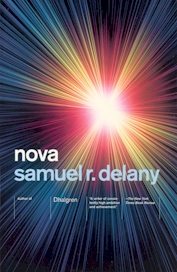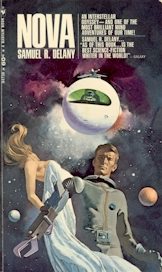
Nova (1968)
1969 Hugo Award Nominee
2002 Vintage Books trade paperback
241 pages (left)
1969 Bantam Books paperback
cover art uncredited
215 pages (right)

Denver Science Fiction & Fantasy Book Club |
 |
Nova (1968) |
 |
|
Amy's summary
Samuel R. Delany - Nova (Warning! Some spoilers) Nova is set in the far future, 3148 to 3172 AD, on planets in the Pleiades Federation and on Earth. It tells of Lorq Von Ray's quest for a vast quantity of the valuable, super-heavy, "something else" elements known as Illyrion. The book starts with a young gypsy, the Mouse, who plays a sensory-syrynx, an instrument that can create illusions of sight, sound, and smell. Mouse just recently got his sockets - one operates tools by plugging them into the sockets in their wrists - and wants to be hired as a cyborg stud on a star-run. The Mouse encounters Blind Dan, whose senses overloaded when he looked at a nova on a mission with Captain Lorq Von Ray. Lorq Von Ray is the heir of a powerful family in the Pleiades Federation. As a kid, Lorq met fellow rich kids Prince and Ruby Red. Prince is missing an arm and won't tolerate anything that can be construed as pointing out his deformity. Prince was cruel even as a child. A dozen years later, Prince invites Lorq to a party in Paris on faraway Earth. Lorq talks with the beautiful Ruby. Prince, who despises Lorq, gets mad, and in a fight slashes Lorq's face. Their families have a history of past animosities. Prince and Ruby are heirs of Red-shift Limited, maker of interstellar space drives, a powerful company in Draco. Lorq's great-great-grandfather prevented the Red-shift from establishing themselves in the Pleiades by blowing up their ships with a atomic cannon. To get back at Prince and assure the Pleiades Federation's independence, Lorq seeks enough Illyrion to upset the balance of power, although it will ruin the economy of two-thirds of the galaxy. He believes he can find such quantities of Illyrion within an exploding sun, a nova. Lorq has tried this mission twice before without success. Captain Lorq Von Ray puts together a spur-of-the-moment crew to fly his ship, the Roc, on a hunt for a nova. Included are the Mouse from Earth with his syrynx; Katin, a tall man from Luna who is perusing the obsolete art of writing a novel; Idas and his albino twin Lynceos, black men from the Outer Colonies who complete each others sentences; and, from the other world of the star in the Pleiades called the Dim Sister, Sebastian, with his dark winged pets and his companion, Ty˙, who reads 3-D dioramic tarot cards. Together they travel from Neptune's moon Triton to the Alkane Institute on Vorpis, a world where net-riders hunt in the polar fog, to learn the location of a star soon to become a nova, and then on to the City of Dreadful Night with its molten river Gold. Eventually they arrive at the star due to explode, beyond the Far Out Colonies. At each stop, Lorq and his crew are confronted by the threatening madman Prince and his sister Ruby Red. summary written by misuly@aol.com |
| Dan | - | Amy | 7.5 |
 |
10 Wow! Don't miss it 8-9 Highly recommended 7 Recommended 5-6 Mild recommendation 3-4 Take your chances 1-2 Below average; skip it 0 Get out the flamethrower! U Unfinishable or unreadable - Skipped or no rating given |
| Cheri | 7 | Barb | - | ||
| Aaron | 7 | Cynthia | - | ||
| Jackie | - | Ron | 6 | ||
| Christine | - | Deb | 8 | ||
| Mike | 7 | Stephanie | - | ||
| Gary | 6 | Monte | 7 |
|
Aaron's Commentary
Samuel R. Delany - Nova
Science fiction's "New Wave" of the 1960s and early '70s was very important to the development of the field, but much of it is almost unreadable in hindsight. To Samuel Delany's credit, Nova is an excellent example of the New Wave movement, yet for the most part it is also comprehensible and entertaining, even if heavy-handed at times. Nova brought a literary sensibility to traditional space opera, opening the door for today's "New Space Opera," and invalidating any dismissal of science fiction as adolescent (although some still try to dismiss it as such even today). The characters of Nova are interesting and nicely enigmatic, with the exception of the persistently evil Prince. The narrative includes many clever touches, such as specifying time and place at the top of each page to keep scenes out of chronological sequence from becoming confusing, and thought-provoking speculations about future science and culture. I especially liked the notion that disbelief in the tarot will be considered superstitious in the future. It may be 35 years old but - allowing for the occasional clunky, overwritten passage - Nova's combination of fun adventure and skillful writing gives it the feel of more contemporary science fiction. What do you think? Your comments are welcome. Please send them to vanaaron@excite.com |